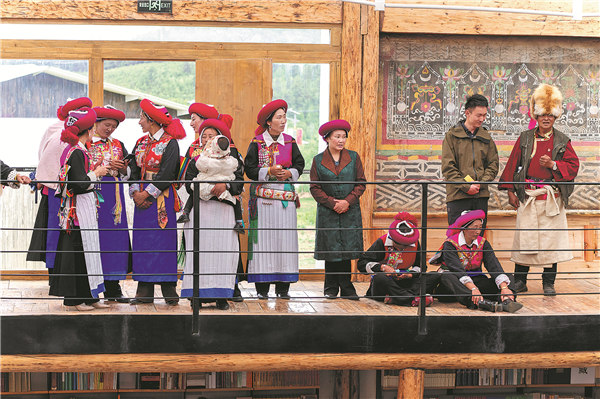

Another is the Sunyata Hotel in Yunnan's Dechen county, which opened at the end of 2018 and sits across the holy Tibetan Meili Snow Mountain. Its predecessor was the renowned Migratory Bird Inn.
In 2022, when Zhao first saw the three rundown Tibetan houses standing in the field, he says he felt this place fits the bookstore's brand ethos.
Typical of traditional Tibetan houses in Shangri-La, the three houses represented the architectural system established by people who had lived there for hundreds of years.
"Their architectural form, the slope of the roof, the way it handles rainfall, and the choice of materials all blend harmoniously with the surrounding environment," Zhao says. "So, we need first to understand and appreciate them before considering whether we can add something new."
Zhao and his team carefully entered the houses, closely observed them and found people like Tsering Dondrub to tell stories about the village.
Zhao was surprised to find that the wooden structure of the three houses is different from those of the houses of the Han people in their building logic.
In the wooden structure of a Han house, the pillars on the first and second floors are often a single piece of wood. However, the pillars on the first floor of a Tibetan house were shorter, more slender and simpler than those on the second floor. The first floor was inhabited by livestock and the second floor by people.
"That is fascinating for an architect like me, who grew up with a modern architectural education. I see it as a precious anthropological legacy that we should carefully preserve," he says.
What also fascinates Zhao is the textured surface of the pillars on the first floor that reveals how they were made — possibly with just an axe — and a painting featuring the eight auspicious symbols every Tibetan household has, along with other anthropological information, which he managed to keep.
With an altitude of more than 3,400 meters, Shangri-La sees its temperature drop to about — 20 C in winter and people would open small windows on the thick rammed-earth walls for insulation and security, making the rooms so dark that during the days, people needed artificial lighting indoors.
In summer, Shangri-La enjoys abundant sunshine, but rich rainfall causes problems for people living under roofs made of wooden tiles, which they regularly need to replace.
Zhao found that the wooden structures were well-preserved, but the roofs had fallen into disrepair.
Considering that a modern bookstore needs proper lighting, Zhao supplanted them with roofs made of translucent polycarbonate panels and galvanized steel roof trusses, inspired by the sunrooms widely used in Shangri-La.